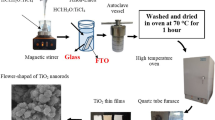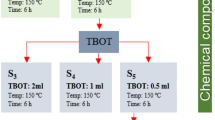Abstract
In this study, ZnO nanotube and nanorod array films were respectively synthesized directly on F-doped SnO2 glass substrate (FTO) using a direct electrodeposition from a simple aqueous zinc salt solution. The effects of potential value, electrodeposition mode and solution stirring speed on the product morphology were investigated. Controlling the reaction under potentiostatic condition of −0.7 V at stirring speed of 300 r/min, large-scale nanotube arrays perpendicular to the substrate can be synthesized at a low temperature of 70 °C. By varying the reaction parameters, we can also obtain ZnO nanorod arrays. The results of X-ray diffraction, scanning electron microscopy, transmission electron microscopy and high-resolution transmission electron microscopy have been provided to characterize the structure and morphology of the nanotube and nanorod arrays. Experiment results show that the as-obtained ZnO has a single crystalline structure and c-axis oriented direction. The room-temperature photoluminescence spectrum of the ZnO nanotube array film displayed its high crystal property available as a photonic material. Electrodeposition is an effective method to prepare ZnO nanotube array films in quantity.
Similar content being viewed by others
References
Martinson A B F, Elam J W, Hupp J T, et al. ZnO nanotube based dye-sensitizied solar cells[J]. Nano Letter, 2007, 7: 2183–2187.
Xia Y N, Yang P D, Sun Y G, et al. One-dimensional nanostructures: Synthesis, characterization and application [J]. Adv Mater, 2003, 15: 353–389.
Huang M H, Mao Samuel, Feick Henning, et al. Room-temperature ultraviolet nanowire nanolasers [J]. Science, 2001, 292: 1897–1899.
Vayssieres L, Keis K, Hagfeldt A, et al. Three-dimensional array of highly oriented crystalline ZnO microtubes [J]. Chem Mater, 2001, 13: 4395–4398.
Kong X Y, Wang Z L. Spontaneous polarization-induced nanohelixes, nanosprings, and nanorings of piezoelectric nanobelts [J]. Nano Lett, 2003, 3: 1625–1631.
Liu Y, Chu Y, Li L L, et al. Controlled fabrication of highly oriented ZnO microrod/microtube arrays on a zinc substrate and their photoluminescence properties[J]. Chem Eur J, 2003, 15: 6667–6683.
Liu B, Zeng H C. Hydrothermal synthesis of ZnO nanorods in the diameter regime of 50 nm[J]. J Am Chem Soc, 2003, 125: 4430–4431.
Ding Y, Gao P X, Wang Z L. Catalyst-nanostructure interfacial lattice mismatch in determining the shape of VLS grown nanowires and nanobelts: A case of Sn/ZnO [J]. J Am Chem Soc, 2004, 126: 2066–2072.
Pauporte T, Lincot D, Heteroepitaxial electrodeposition of zinc oxide films on gallium nitride [J]. Appl Phys Lett, 1999, 75: 3817–3819.
Banfield J F, Welch S A, Zhang H Z, et al. Aggregation-based crystal growth and microstructure development in natural iron oxyhydroxide biomineralization products [J]. Science, 2000, 289: 751–754.
Lee M K, Tu H F. Optical emissions of Zn and ZnO in Zn-ZnO structure synthesized by electrodeposition with aqueous solution of zinc nitrate-6-hydrate [J]. Crystal Growth and Design, 2008, 8: 1785–1788.
Guo H H, Zhou J Z, Lin Z H. ZnO nanorod light-emitting diodes fabricated by electrochemical approaches [J]. Appl Phys Lett, 2004, 84: 4098–4100.
Elias J, Zaera R T, Wang Y S et al. Conversion of ZnO nanowires into nanotubes with tailored dimensions [J]. Chem Mater, 2008, 20(21): 6633–6637.
Xu L F, Liao Q, Zhang J P, et al. Single-crystalline ZnO nanotube arrays on conductive glass substrates by selective disolution of electrodeposited ZnO nanorods [J]. J Phys Chem C, 2007, 111: 4549–4552.
Tang Y W, Luo L J, Chen Z G, et al. Electrodeposition of ZnO nanotube arrays on TCO glass substrates [J]. Electrochem Commun, 2007, 9: 289–292.
Umar A, Hahn Y B. ZnO nanosheet networks and hexagonal nanodiscs grown on silicon substrate: growth mechamisn and structural and optical properties [J]. Nanotechnology, 2006, 17: 2174–2180.
Penn R L, Banfield J F. Imperfect oriented attachment: Dislocation generation in defect-free nanocrystals [J]. Science, 1998, 289: 969–971.
Author information
Authors and Affiliations
Corresponding author
Additional information
Foundation item: Supported by Self-Determined Research Funds of Huazhong Normal University from the Colleges’ Basic Research and Operation of Ministry of Education (CCNU09A02011) 1899.
Biography: LUO Lijuan, female, Ph. D. candidate, research direction: preparation of semiconductor and the application in solar cells.
Rights and permissions
About this article
Cite this article
Luo, L., Lü, G., Li, B. et al. Controlled growth of ZnO array on FTO glass substrate by electrodeposition. Wuhan Univ. J. Nat. Sci. 15, 130–134 (2010). https://doi.org/10.1007/s11859-010-0209-6
Received:
Published:
Issue Date:
DOI: https://doi.org/10.1007/s11859-010-0209-6




